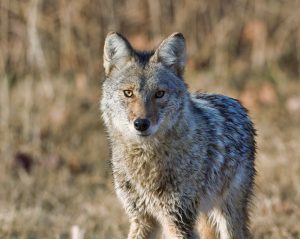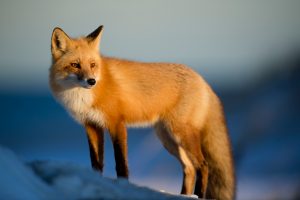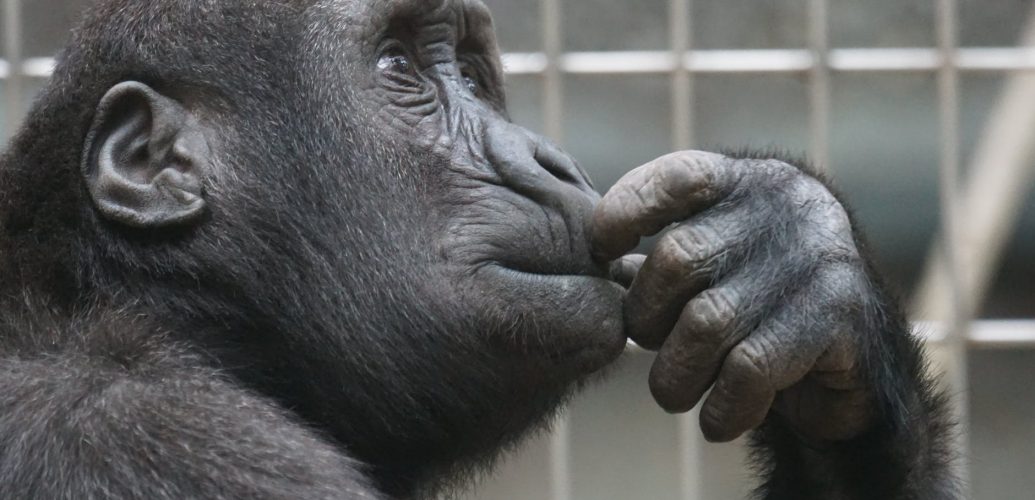Twenty years ago, when I was a host of Daily Planet on Discovery Channel Canada, a handful of us went to Africa to shoot a set of stories.
I definitely landed the plum assignment: go to Jane Goodall’s Gombe reserve and do a story on the chimpanzees. It was a one-day shoot to do what the trackers there had been doing ever since Dr. Goodall set up shop: pick a chimpanzee and follow it all day, making detailed notes on its behaviour.
Notice I just used the word “its”, as in “its behaviour”. In this case, it isn’t appropriate because from the beginning Dr. Goodall had named all the chimps. To her it made much more sense than just giving them numbers, although in those days, the late 60s and early 70s, she was definitely swimming against the scientific tide. She was “anthropomorphizing”.

In the middle of my day there, we were following our designated chimp Patty and her offspring when suddenly and loudly the alpha male, Frodo, scrambled down the trunk of a tree beside us. To be within a few metres of the legendary and fierce Frodo was an amazing thrill. The name meant something to me.
A typical definition of anthropomorphism online is: “the attribution of human characteristics or behaviour to a god, animal, or object.” Not a bad definition, but not perfect.
Although all three betray human tendencies, they don’t deserve equal billing, because gods and objects behaving like humans are themselves the products of human imagination. Yes, Greek gods behave like humans, usually surly, bad-tempered humans, but we made them that way. The same for inanimate objects that behave like humans (Cogsworth and Lumiere in Disney’s Beauty and the Beast). Of these three anthropomorphized entities, only animals have their own independent existence, and that makes them, and our insistence on turning them into replica humans, special.
My podcast co-hosts, Niki Wilson and Erika Siren, and I coined the term “Anthropomania” to describe the most extreme instances of humans desperately embellishing wildlife with human qualities. The more you look, the more you find. We ran into this head-on when we were thinking of a podcast about foxes and coyotes, two animals that, depending on your cultural background, have very different reputations. Those reputations reflected perfect examples of Anthropomania.
Crazy Like a Fox
An English farmer who raises chickens tells the story of a fox who broke into the chicken pen, killed one chicken for food and then slaughtered all the rest out of sheer ‘spite’. Apparently the fox, angry and resentful of the farmer, spitefully gave him the vulpine middle finger.
Just foolish.
To argue that the fox acted out of spite is to project a load of human emotions onto the poor animal. With no evidence. It’s true that foxes and wolves sometimes perform what’s called “surplus killing”, but it happens in the wild as well as the henhouse, where there are no humans to be spiteful towards.

Photo by Steve Creek on Pexels.com 
Fox
Animal behaviour experts are not unanimous in their explanations of this behaviour, but would surely put ‘spite’ at the bottom of any list. A fox on the run, if spotted, would have been shot by the farmer or, only in England, a fox might perish instead amid the pomp and circumstance of the traditional English fox hunt. Now no longer legal, the hunt was Anthropomania of a special kind, which the British Prime Minister Boris Johnson once called “semi-sexual”, and fans of the hunt lamented its cessation by arguing on the fox’s behalf: “Who then is going to value the fox? Who’s going to speak for it? Who’s going to be concerned about its welfare?” The fox is both glorified and doomed.
Why did Assyrian kings bring back the flora and fauna of the lands they had just conquered, display them in huge parks and hunt them? To assert their dominion over those conquered by identifying the wildlife with the humans who had been subjugated.
Why have taxidermists, over time, produced everything from scenes of nature at its most violent to squirrels having tea? The tendency sometimes to recast animals as furry humans, to just go a little too far ? That’s pure Anthropomania. But the push back against it has stalled the science too.
Science and the Dreaded P (personality)
For decades, even though Jane Goodall had shown the way, animal behaviourists shied away – even rejected – the term personality. That day at Gombe was hot. I remember doing a short on camera piece at 6:45 AM, shirt already soaked with sweat. And Patty, our chimp, was living up to her reputation by preferring to move overland through the jungle rather than sticking to the paths. That meant that Mike Heenan, the cameraman, sometimes had to crawl through the underbrush, with his camera on his back. One of the guides said something about snakes. One thing was clear: as far as I could tell, Patty couldn’t have cared less that we were there. She was her own individual, a personality.
That chimps have personalities isn’t really surprising to anyone. But ants? Yes … ants have personalities, at least the way scientists define the word: variation in behaviour between individuals in a single species. Some ants explore; some stick around the nest: those are two different ant personalities.
The idea of animal “personality” took decades before it won over those wary on anthropomorphism. But it’s been even more difficult for plants, or rather, for us to accept the idea that plants might be, if not intelligent, way more complex and active than we thought 25 years ago. We have a long way to go, because even as more and more scientists agree that plants communicate in various ways, recognize their kin and work together as communities, we are probably still failing to recognize just how much more they might be capable of.
Anthropomania the podcast brings together an unreal cast of characters:. where else might you hear Jane Goodall and Pablo Escobar in the same podcast? And let’s not forget Joe Exotic. There are dozens of others you might not know now, but you will. If this were a movie, the animal wranglers would have their hands full, with cane toads, wild pigs, tigers, zebra mussels, house sparrows and female spiders who cannibalize their prospective mates. Now that’s personality!
Come with us and we’ll show you just how much the human lens distorts nature, its creatures and its plants.
Subscribe today on your favourite app.






